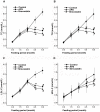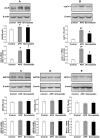Astragalus polysaccharides lowers plasma cholesterol through mechanisms distinct from statins
- PMID: 22110652
- PMCID: PMC3217967
- DOI: 10.1371/journal.pone.0027437
Astragalus polysaccharides lowers plasma cholesterol through mechanisms distinct from statins
Abstract
To determine the efficacy and underlying mechanism of Astragalus polysaccharides (APS) on plasma lipids in hypercholesterolemia hamsters. The effect of APS (0.25 g/kg/d) on plasma and liver lipids, fecal bile acids and neutral sterol, cholesterol absorption and synthesis, HMG-CoA reductase activity, and gene and protein expressions in the liver and small intestine was investigated in twenty-four hypercholesterolemia hamsters. Treatment periods lasted for three months. APS significantly lowered plasma total cholesterol by 45.8%, triglycerides by 30%, and low-density lipoprotein-cholesterol by 47.4%, comparable to simvastatin. Further examinations revealed that APS reduced total cholesterol and triglycerides in the liver, increased fecal bile acid and neutral sterol excretion, inhibited cholesterol absorption, and by contrast, increased hepatic cholesterol synthesis and HMG-CoA reductase activity. Plasma total cholesterol or low-density lipoprotein-cholesterol levels were significantly correlated with cholesterol absorption rates. APS up-regulated cholesterol-7α-hydroxylase and LDL-receptor gene expressions. These new findings identify APS as a potential natural cholesterol lowering agent, working through mechanisms distinct from statins.
Conflict of interest statement
Figures




Similar articles
-
Cholesterol-lowering effects and potential mechanisms of different polar extracts from Cyclocarya paliurus leave in hyperlipidemic mice.J Ethnopharmacol. 2015 Dec 24;176:17-26. doi: 10.1016/j.jep.2015.10.006. Epub 2015 Oct 23. J Ethnopharmacol. 2015. PMID: 26477373
-
Cranberry anthocyanin as an herbal medicine lowers plasma cholesterol by increasing excretion of fecal sterols.Phytomedicine. 2018 Jan 1;38:98-106. doi: 10.1016/j.phymed.2017.11.008. Epub 2017 Nov 21. Phytomedicine. 2018. PMID: 29425660
-
Increasing hepatic cholesterol 7alpha-hydroxylase reduces plasma cholesterol concentrations in normocholesterolemic and hypercholesterolemic rabbits.Hepatology. 1996 Oct;24(4):882-7. doi: 10.1002/hep.510240421. Hepatology. 1996. PMID: 8855192
-
Cholesterol metabolism and therapeutic targets: rationale for targeting multiple metabolic pathways.Clin Cardiol. 2004 Jun;27(6 Suppl 3):III16-21. doi: 10.1002/clc.4960271506. Clin Cardiol. 2004. PMID: 15239487 Free PMC article. Review.
-
1994 Mack-Forster Award Lecture. Review. Studies on the regulation of hepatic cholesterol metabolism in humans.Eur J Clin Invest. 1995 Apr;25(4):215-24. doi: 10.1111/j.1365-2362.1995.tb01552.x. Eur J Clin Invest. 1995. PMID: 7601197 Review. No abstract available.
Cited by
-
Astragalus polysaccharide mitigates transport stress-induced hepatic metabolic stress via improving hepatic glucolipid metabolism in chicks.J Anim Sci. 2022 Sep 1;100(9):skac244. doi: 10.1093/jas/skac244. J Anim Sci. 2022. PMID: 35866893 Free PMC article.
-
Renoprotective Effect of the Shen-Yan-Fang-Shuai Formula by Inhibiting TNF-α/NF-κB Signaling Pathway in Diabetic Rats.J Diabetes Res. 2017;2017:4319057. doi: 10.1155/2017/4319057. Epub 2017 Jun 21. J Diabetes Res. 2017. PMID: 28713834 Free PMC article.
-
Polymeric Compounds of Lingonberry Waste: Characterization of Antioxidant and Hypolipidemic Polysaccharides and Polyphenol-Polysaccharide Conjugates from Vaccinium vitis-idaea Press Cake.Foods. 2022 Sep 11;11(18):2801. doi: 10.3390/foods11182801. Foods. 2022. PMID: 36140930 Free PMC article.
-
Relationship between molecular weight, monosaccharide composition and immunobiologic activity of Astragalus polysaccharides.Glycoconj J. 2016 Oct;33(5):755-61. doi: 10.1007/s10719-016-9669-z. Epub 2016 Apr 30. Glycoconj J. 2016. PMID: 27129881
-
Hua-Tan-Sheng-Jing Decoction Treats Obesity With Oligoasthenozoospermia by Up-Regulating the PI3K-AKT and Down-Regulating the JNK MAPK Signaling Pathways: At the Crossroad of Obesity and Oligoasthenozoospermia.Front Pharmacol. 2022 Apr 26;13:896434. doi: 10.3389/fphar.2022.896434. eCollection 2022. Front Pharmacol. 2022. PMID: 35559247 Free PMC article.
References
-
- Collins R, Armitage J, Parish s, Sleight P, Peto R, et al. MRC/BHF Heart Protection Study of cholesterol lowering with simvastatin in 20,536 high-risk individuals: a randomised placebo-controlled trial. Lancet. 2002;360:7–22. - PubMed
-
- Lenfant C, Cleeman JI, Ganiats TG, Graham G, Kleinman RE, et al. Executive Summary of The Third Report of The National Cholesterol Education Program (NCEP) Expert Panel on Detection, Evaluation, And Treatment of High Blood Cholesterol In Adults (Adult Treatment Panel III). JAMA. 2001;285:2486–2497. - PubMed
-
- Huang X, Wang D, Hu Y, Lu Y, Guo Z, et al. Effect of sulfated astragalus polysaccharide on cellular infectivity of infectious bursal disease virus. Int J Biol Macromol. 2008;42:166–171. - PubMed
Publication types
MeSH terms
Substances
LinkOut - more resources
Full Text Sources
Other Literature Sources
Medical
Miscellaneous

